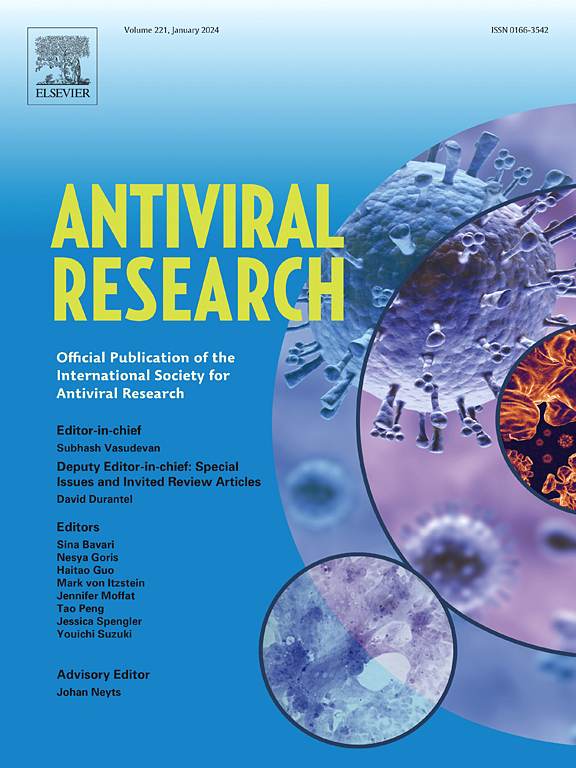Antiviral susceptibility monitoring: testing algorithm, methods, and findings for influenza season, 2023–2024
IF 4
2区 医学
Q1 PHARMACOLOGY & PHARMACY
引用次数: 0
Abstract
Antiviral susceptibility monitoring is integral to influenza surveillance conducted by CDC in collaboration with partners. Here, we outlined the algorithm and methods used for assessing antiviral susceptibility of viruses collected during 2023–2024 season. Virus specimens were provided by public health laboratories in the United States (US) and by laboratories in other countries that belong to the Pan American Health Organization. In the US, antiviral susceptibility surveillance conducted nationally is strengthened by sequence-only analysis of additional viruses collected at a state level. Viral genome sequence analysis was the primary approach to assess susceptibility to M2 blockers (n = 5123), neuraminidase (NA) inhibitors (n = 6874), and a polymerase acidic protein (PA) inhibitor (baloxavir, n = 6567). Over 99 % of type A viruses had M2-S31N that confers resistance to M2 blockers. Although oseltamivir-resistant viruses carrying NA-H275Y (N1 numbering) were rare (0.35 %), a cluster of four such viruses was identified in Haiti. Viruses with other NA mutations conferring reduced inhibition by NA inhibitor(s) were also detected sporadically. This includes a cluster of three influenza B viruses in Texas that shared a new mutation, NA-A245G conferring reduced inhibition by peramivir. Three viruses with reduced baloxavir susceptibility were identified, which had PA-I38T, PA-Y24C or PA-V122A; the latter two new mutations identified through augmented approach to sequence analysis. To monitor baseline susceptibility, supplementary in vitro testing was conducted on approximately 7 % of viruses using NA inhibition assay and cell culture-based assay IRINA. Implementation of Sequence First approach provided comprehensive and high throughput methodology for antiviral susceptibility assessment and reduced redundant phenotypic testing.
2023-2024年流感季节抗病毒药物敏感性监测:检测算法、方法和结果
抗病毒药物敏感性监测是疾病预防控制中心与合作伙伴合作开展的流感监测的组成部分。在此,我们概述了用于评估2023-2024季节收集的病毒抗病毒敏感性的算法和方法。病毒标本由美国的公共卫生实验室和泛美卫生组织其他国家的实验室提供。在美国,通过对州一级收集的其他病毒进行仅序列分析,加强了在全国范围内进行的抗病毒药物敏感性监测。病毒基因组序列分析是评估M2阻滞剂(n=5123)、神经氨酸酶(NA)抑制剂(n=6874)和聚合酶酸性蛋白(PA)抑制剂(baloxavir, n=6567)易感性的主要方法。超过99%的A型病毒含有M2- s31n,这种病毒对M2阻滞剂有抵抗力。虽然携带NA-H275Y (N1编号)的奥司他韦耐药病毒很少见(0.35%),但在海地发现了四种此类病毒。具有其他NA突变的病毒对NA抑制剂的抑制作用降低,也偶有发现。这包括德克萨斯州的三种乙型流感病毒群,它们共有一种新的突变,NA-A245G,使帕拉米韦的抑制作用降低。鉴定出3种降低巴洛韦敏感性的病毒,分别为PA-I38T、PA-Y24C和PA-V122A;后两种新突变是通过扩增序列分析方法鉴定出来的。为了监测基线敏感性,对大约7%的病毒进行了补充体外测试,使用NA抑制试验和基于细胞培养的IRINA试验。序列优先方法的实施为抗病毒药物敏感性评估提供了全面和高通量的方法,减少了冗余的表型检测。
本文章由计算机程序翻译,如有差异,请以英文原文为准。
求助全文
约1分钟内获得全文
求助全文
来源期刊

Antiviral research
医学-病毒学
CiteScore
17.10
自引率
3.90%
发文量
157
审稿时长
34 days
期刊介绍:
Antiviral Research is a journal that focuses on various aspects of controlling viral infections in both humans and animals. It is a platform for publishing research reports, short communications, review articles, and commentaries. The journal covers a wide range of topics including antiviral drugs, antibodies, and host-response modifiers. These topics encompass their synthesis, in vitro and in vivo testing, as well as mechanisms of action. Additionally, the journal also publishes studies on the development of new or improved vaccines against viral infections in humans. It delves into assessing the safety of drugs and vaccines, tracking the evolution of drug or vaccine-resistant viruses, and developing effective countermeasures. Another area of interest includes the identification and validation of new drug targets. The journal further explores laboratory animal models of viral diseases, investigates the pathogenesis of viral diseases, and examines the mechanisms by which viruses avoid host immune responses.
 求助内容:
求助内容: 应助结果提醒方式:
应助结果提醒方式:


